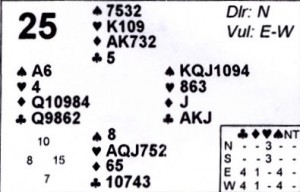Nobody bid it Continue reading
 One hand at the Saturday pairs game at the Hartford Bridge club stuck in my craw. We would have done a little better if I had analyzed hand #25 correctly. I was in the West chair, and we were vulnerable. The bidding was fairly predictable up to my second bid:
One hand at the Saturday pairs game at the Hartford Bridge club stuck in my craw. We would have done a little better if I had analyzed hand #25 correctly. I was in the West chair, and we were vulnerable. The bidding was fairly predictable up to my second bid:
| North | Pard | South | Me |
| Pass | 1♠ | 2♥ | Double |
| 3♥ | 3♠ | Pass | ? |
Should I raise to four, or should I pass? I was actually hoping that South would bid 4♥, in which case I would certainly have bid the spade game. When she did not, my mental process was something like the following:
- Partner might be showing extra values, or he might just be competing with seven or so spades.
- We probably had a fit, so I counted losers. There were surprisingly only six, but that was assessing both unsupported queens as winners. Since partner had shown no interest in my minor suits, one or both might not be worth much in practice.
- The opponents could have as few as eight trump. Only one (or even none if the opponents lead trump) can probably be ruffed one in my hand.
It was hard for me to imagine that partner could find ten tricks. So, I passed. It was a mistake. He was easily able to score the required tricks. In retrospect, I surmise that I was guilty of using 1960’s thinking; I paid too much attention to the quality of my holding and not enough to my distribution. The key fact might have been the unfavorable vulnerability. Someone at the table was probably stretching his/her values, but it was unlikely to be my partner. If I placed him with the expected seven or fewer losers (he actually had six), then I should have bid 4♠ in a shot. Even if I depreciated one of my queens, we still would have only fourteen losers. Losing Trick Count says that we should be in game.
I have found that LTC is pretty accurate through four-level bids. Marty Bergen’s method of adjusting point count is another good method. In this case, I have eight high-card points. The singleton brings it up to eleven (although with only two trumps, I might only add two for it), and my two long suits makes this hand easily strong enough for game. I definitely should have bid 4♠.
Maybe someday I will be good enough to use “judgment” to make these decisions, but for the next decade or so, I plan to rely on the conclusions of others with more experience than I have. After all, partner’s hand was far from ideal. We had duplicated values in clubs, and his ♦J only contributes if South leads her singleton trump. He had no wasted values in hearts, but that was indicated by the opponents’ bidding.
I was pleased to discover from the results sheet that we actually got a good score on this board. No one played in 4♠; although one North-South pair played in 5♥. They probably were pushed. In fact, some declarers only managed nine tricks. Perhaps South led a trump. In that case declarer must immediately abandon the idea of ruffing a heart and take advantage of the surprisingly favorable diamond layout to establish that suit before squandering the ♠A as an entry.

 Cold Game in Spades
Cold Game in Spades